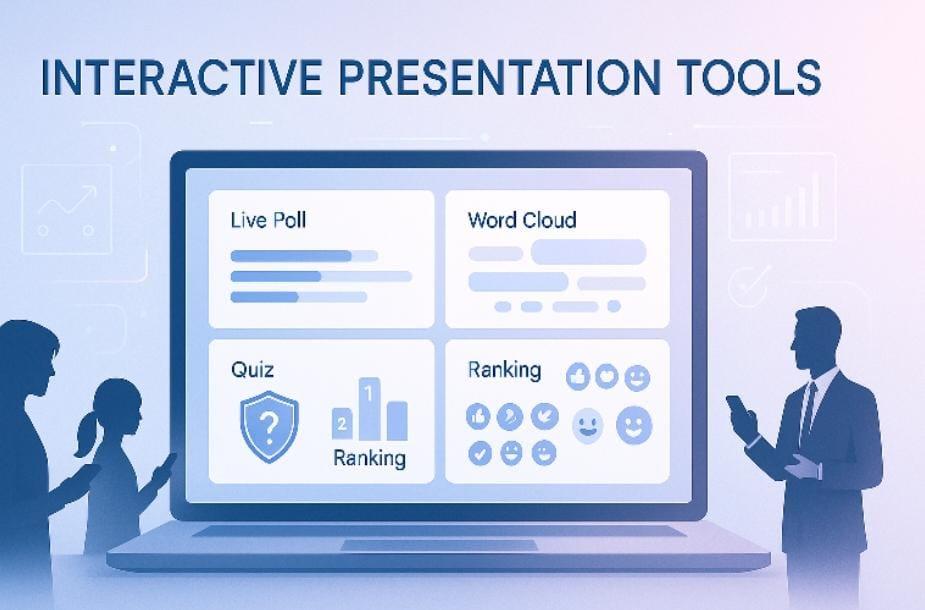
Slidea Releases Comprehensive Guide On Modern Interactive Presentation Tools
The new resource highlights how interactive technologies are transforming classrooms, corporate training, and virtual communication.
The guide presents a descriptive and informative analysis of today's most widely used interactive technologies, offering valuable insights for educators, trainers, and professionals.
As educators, trainers, and professionals increasingly search for ways to keep audiences attentive and engaged, Slidea today announced the release of a detailed guide explaining the evolution and key capabilities of modern interactive presentation tools. The report outlines how such platforms are reshaping communication by turning traditional slide-based sessions into highly participatory, conversation-driven experiences from, live polling and word clouds to browser-based participation and mobile-controlled remote access. It highlights how these tools support deeper learning, faster decision-making, and improved engagement across physical, virtual, and hybrid environments.
Growing Need for Interactive Communication
Modern audiences, whether students, employees, or workshop participants, expect more than one-way presentations. The report notes a significant shift toward interactive presentation softwar, which enables real-time involvement through mobile-based participation, quick response tools, and engaging slide formats.
“Traditional slides are no longer enough in high-engagement environments,” the report states.“Interactive features make participants active contributors instead of passive listeners, ensuring the session remains dynamic throughout.”
Key Highlights From the Guide
Slidea has released a how-to guide that covers a wide spectrum of interactive features now commonly used across global classrooms, meeting rooms, and digital events. Major sections include:
1. Two-Way Interaction Becomes the New Standard
Modern platforms now provide a framework for audience participation using QR codes and browser access. Participants can vote, answer, react, or contribute ideas instantly using their mobile devices.
Popular interaction formats include:
Live polls
MCQs & quiz modules
Word clouds
Ranking slides
This-or-that comparisons
Open-ended text responses
Emoji-based reactions
Numeric guessing prompts
2. Live Polling for Instant Insights
The guide highlights how interactive live polls allow presenters to collect viewpoints in real time, ideal for session introductions, knowledge checks, or decision-making moments. Anonymous responses help participants share more openly, improving the quality of insights.
3. Interactive Quizzes With Scoring & Leaderboards
Quizzes enhance learning outcomes by enabling:
Single/multiple-choice questions
Timed answers
Automatic scoring
Optional leaderboards
Instant explanation of correct responses
They help break long sessions into shorter, more engaging segments.
4. Word Clouds for Group Brainstorming
Used widely in workshops and classrooms, word clouds turn group thoughts into visual clusters, ideal for icebreakers, topic introductions, or recaps.
5. Ranking Tools for Prioritization
Ranking boards help teams collectively decide priorities for training topics, project goals, or workshop flows.
6. Quick Engagement With“This-or-That” Activities
These lightweight comparison questions help energize audiences between long content sections and boost participation in hybrid sessions.
7. Open-Ended Input for Detailed Feedback
Participants can type freely, providing richer insight during reflective tasks, storytelling, surveys, or post-session evaluations.
8. Survey Mode for Structured Assessments
Modern tools allow multiple questions, both numerical and descriptive, to be compiled into one survey. This supports event evaluation, learning assessment, or pre-training checks.
9. Emoji Reactions for Emotional Feedback
Instant emoji-based responses help presenters understand audience mood, useful for younger learners or informal sessions.
10. Gamified Number Guessing for Energy Boosts
Numeric guessing rounds bring fun competition to corporate and classroom environments.
11. Browser-Based Participation, No App Required
Platforms now prioritize zero-download access, ensuring:
Higher participation rates
Compatibility with restricted devices
Easy onboarding across age groups
Smooth functioning on mobile, tablet, or laptop browsers
12. Clean Presenter Interface for Ease of Use
Dashboards include slide previews, timers, answer visibility toggles, and real-time activity tracking, making them accessible to first-time users.
13. Designed for Classroom, Corporate & Workshop Environments
The guide outlines how different sectors benefit uniquely:
Classrooms: Active learning, inclusive participation
Corporate training: Structured decision-making, knowledge validation
Workshops/Events: Managing large groups, energizing hybrid audiences
14. Tutorials and Beginner Support
Most platforms now offer complete learning resources, such as step-by-step guides, sample slides, quick videos, and FAQs.
15. Free Audience Participation
Participants rarely need an account or subscription, making the tools suitable for schools, NGOs, public programs, and corporate town halls.
16. Compatibility With Physical, Virtual & Hybrid Events
The guide explains how the same interactive slides adapt seamlessly across:
Zoom / Teams / Google Meet
Classroom screens
Auditoriums
Offline workshops
17. Analytics for Smarter Decision-Making
Data from polls, surveys, and quizzes allows presenters to analyze:
Engagement patterns
Knowledge gaps
Overall session effectiveness
Participant preferences
18. Mobile-Based Remote Access for Presenters
One of the emerging features covered is remote access, which allows presenters to navigate slides from their mobile phone, a major advantage in classrooms, workshops, or collaborative training setups.
Remote control supports:
Slide navigation
Triggering interactive activities
Managing timers
Showing/hiding audience results
This adds freedom of movement and improves the natural flow of presentations.
Industry Context & Significance
As remote and hybrid communication continues to expand globally, interactive technologies have become essential for maintaining attention in digital environments. The guide underscores the need for organization, schools, and facilitators to adopt tools that foster participation rather than passive listening.
“Interactivity is no longer optional,” the report concludes.“It is now a core expectation across learning and business environments.”
About the Guide
The newly released report aims to help institutions, educators, HR teams, workshop facilitators, and corporate trainers better understand the function and impact of emerging presentation technologies. The content is fully neutral and not tied to any one platform, making it an objective resource for decision-makers evaluating interactive solutions.

Legal Disclaimer:
MENAFN provides the
information “as is” without warranty of any kind. We do not accept
any responsibility or liability for the accuracy, content, images,
videos, licenses, completeness, legality, or reliability of the information
contained in this article. If you have any complaints or copyright
issues related to this article, kindly contact the provider above.


















Comments
No comment